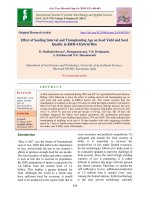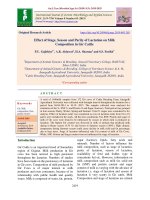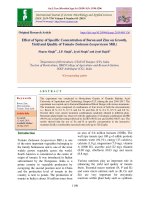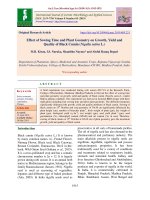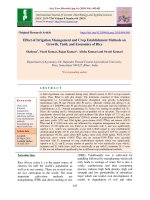Effect of feeding dried distiller’s grains plus solubles on milk yield and its composition in dairy cattle
Bạn đang xem bản rút gọn của tài liệu. Xem và tải ngay bản đầy đủ của tài liệu tại đây (256.7 KB, 7 trang )
Int.J.Curr.Microbiol.App.Sci (2018) 7(3): 1861-1867
International Journal of Current Microbiology and Applied Sciences
ISSN: 2319-7706 Volume 7 Number 03 (2018)
Journal homepage:
Original Research Article
/>
Effect of Feeding Dried Distiller’s Grains Plus Solubles on Milk Yield and
its Composition in Dairy Cattle
Sajjan Sihag1, Zile Singh Sihag1, Sushil Kumar1* and Narender Singh2
1
Department of Animal Nutrition, 2Department of Livestock Production Management, College
of Veterinary Sciences, LUVAS, Hisar-125004, Haryana, India
*Corresponding author
ABSTRACT
Keywords
DDGS, Cross bread
Cattle, Milk yield,
Composition
Article Info
Accepted:
16 February 2018
Available Online:
10 March 2018
Sixteen crossbred lactating cattle of average 411.75±14.23kg body weight, 14.01±1.38
milk yield and 30.87±6.10 DIM were divided into four treatment groups of four animals
each on the basis of milk yield and parity following completely randomized design. All the
experimental animals were fed weighed quantities of wheat straw, green fodder and
concentrate mixture to meet out the requirements as per feeding standards
(NRC, 2001). The concentrate mixture of lactating cattle of treatment groups T 2, T3 and T4,
the CP of GNC of control group was replaced with CP of DDGS @ 50, 75, and 100 %,
respectively. For cattle fed 50 and 100% DDGS in place of groundnut cake CP intake
increased (P<0.05) as compared to the cattle fed control diets containing no DDGS. No
significant difference among control and treatment groups revealed that concentrate
mixtures having either groundnut cake or DDGS were equally accepted by the
experimental cattle. Nutrient digestibility and dry matter, DCP & TDN intake in lactating
cattle are not affected by replacing 50% groundnut cake with DDGS in their concentrate
mixture. Nutritive value in terms of DCP & TDN percent of the ration fed to cattle and
feed efficiency & feed conversion ratio are not affected at 50% substitution level. Milk
yield, its composition and energy value of milk in crossbred cattle are not impacted due to
substituting 50 % ground nut cake with distiller’s dried grains with soluble as primary
protein source in their concentrate mixture, however,4% FCM yield augmented. There was
net saving of Rs. 1.32 for feed cost per kg FCM production in cattle by feeding 50%
DDGS, as protein source in place of ground nut cake.
Introduction
In developing countries like India, the
increasing cost and decreasing supply of
traditional feedstuffs are expected to constrain
the future expansion of livestock production.
Feed prices have increased sharply due to
increase in the feed ingredient prices. The
availability of low-priced, high-quality feeds
is critical for the expansion of the dairy
industry. DDGS is one of residual coproduced from the production of ethanol from
grain after fermentation of the starch (Youssef
et
al.,
2013).
The
non-fermentable
components of this process which are rich in
essential nutrients such as protein, fat, fiber,
1861
Int.J.Curr.Microbiol.App.Sci (2018) 7(3): 1861-1867
vitamins and minerals are recovered in a
highly concentrated form (approximately 3
fold) as distillers dried grains with solubles
(NRC, 1994; Weigel et al., 1997; AAFCO
2002). DDGS from alcohol industry is a
valuable source of energy, protein, water
soluble vitamins and minerals for dairy
animals. Feed prices have increased sharply
due to increase in the feed ingredient prices.
DDGS supply energy, protein (amino acids),
linolic acid and phosphorus in poultry diet
often at a competition price and may lower
feed cost (Youssef et al., 2013). Hoffman and
Baker (2010) showed that DDGS prices
relative to alternate feed ingredients have
declined in to a favorable feeding range for
many different types of livestock and poultry.
Wet and dry distiller’s grains are excellent
feed ingredients for use in lactating dairy cow
rations. Distiller’s grains can replace more
expensive sources of protein, energy, and
minerals in dairy cow diets. Feeding of DDGS
to lactating dairy cows has been shown
previously to increase the concentration of
unsaturated fatty acids in milk fat.
Kleinschmit et al., (2006) evaluated the effects
of feeding total mixed diets containing 20%
DDGS and found that the DDGS sources used
in this study did not affect lactation
performance. Anderson et al., (2006)
determined the effects of feeding 10% or 20%
dried or wet distiller’s grains with soluble and
reported improved feed efficiency and energycorrected milk/kg of DMI by increasing yield
of milk, protein, and fat while dry matter
intake tended to decrease. Kleinschmit et al.,
(2007) observed that replacing corn silage
with alfalfa hay in diets containing 15%
DDGS increased milk yield, and tended to
linearly increase milk protein yield in cows
during late lactation. Janicek et al., (2008)
suggested that lactating dairy cow rations can
contain as much as 30% DDGS and support
satisfactory lactation performance and milk
composition. Kalscheur and Garcia (2004)
reported that DDGS can be added to growing
heifer rations at levels up to 40% of dry matter
intake to achieve excellent growth rate and
feed conversion.
Due to increased interest and availability of
this feed stuff, the present study has been
planned to conduct to evaluate the effect of
feeding dried distiller’s grains plus solubles on
milk yield and its composition in dairy cattle.
Materials and Methods
The study was conducted at the Lala Lajpat
Rai University of Veterinary and Animal
Sciences, Hisar, Haryana, India. Sixteen
crossbred lactating cattle of average
411.75±14.23kg body weight, 14.01±1.38
milk yield and 30.87±6.10 DIM were divided
into four treatment groups viz. T1, T2, T3 and
T4, of four animals each on the basis of milk
yield and parity following completely
randomized design
(CRD). All
the
experimental cattle were tied with rope in well
ventilated feeding stall having arrangement for
individual feeding. Before commencement of
actual trial animals were acclimatized with
experimental feeds for 10 days followed by
115 days of experimental feeding and five
days of digestion trial. All the experimental
animals were fed weighed quantities of wheat
straw, green fodder and concentrate mixture to
meet out the requirements as per feeding
standards
(NRC, 2001). The
concentrate
mixture of control group (T1) was comprised
of Maize grain (37), GNC (35), rice polish
(25), mineral mixture (2) and common salt (1
part), while, in the concentrate mixture of
lactating cattle of treatment groups T2, T3 and
T4, the CP of GNC of control group was
replaced with CP of DDGS @ 50, 75, and 100
%, respectively. Ingredient and chemical
composition of different concentrate mixtures
fed to experimental animals is given in Table
1. The feed intake was recorded at fortnightly
intervals on two consecutive days, the average
of two days intake was used for daily dry
1862
Int.J.Curr.Microbiol.App.Sci (2018) 7(3): 1861-1867
matter and crude protein intake. Daily milk
yield of morning and evening of individual
animal was recorded using digital balance.
The milk was sampled at interval of fifteen
days for each animal in separate bottles of
both morning and evening and mixed before
proceeding for estimation of major
constituents of milk. Fat and protein
percentage were estimated with the help of
milk analyzer. Total solids in milk were
estimated by Gravimetric method. Fat
corrected milk and energy value of milk were
calculated by the method of Tyrrel and Reid
(1965) by the following formulae:
4% FCM (Kg) = 0.4 x total milk (kg) + 15 x
total fat
EVM (Mcal/kg) = 0.0929 x fat% + 0.0547 x
CP% + 0.192
Economics of feeding distiller’s dried grains
plus soluble as substitute of groundnut cake
protein in concentrate mixture of crossbred
lactating cattle was calculated. At the end of
experimental period a digestion trial of five
days was conducted by manual quantitative
collection of total faeces from individual
animal offered weighed quantity of test diet
and recording its refusal. The samples of feed
offered, refusals and faeces were analyzed for
proximate principles (AOAC, 2005) and fiber
fractions (Van Soest et al., 1991).
Results and Discussion
The chemical analysis of the concentrate
mixture revealed that ether extract decreases,
while NDF and ADF increases as the level of
DDGS increased in the concentrate mixture.
The average value of dry matter intake (DMI)
per day during the 105 day experimental
period was not affected significantly by
replacing different levels of groundnut cake
with DDGS as primary source of protein in
concentrate mixture of lactating cattle. Crude
protein intake was increased by the addition of
distiller’s grains in dairy cow diets. For cattle
fed 50 and 100% DDGS in place of groundnut
cake CP intake increased (P<0.05) as
compared to the cattle fed control diets
containing no DDGS (Table 3). Dry matter
intake of experimental lactating cattle in terms
of percent body weight and per kg metabolic
body size (W 0.75kg) did not differ
significantly among different dietary treatment
groups.
No significant difference among control and
treatment groups revealed that concentrate
mixtures having either groundnut cake or
DDGS were equally accepted by the
experimental cattle. It was also observed that
all the experimental animals were in positive
body weight balance and body weight gain of
lactating cattle during experimental did not
differ significantly due to different
replacement levels of GNC with DDGS in
their concentrate mixtures (Table 2).
The digestibility of dry matter, crude fibre and
NFE, were comparable in all four treatment
groups, however, crude protein, ether extract
and organic matter digestibility values were
significantly (P<0.05) less in cattle of
treatment groups T3 (75% DDGS) and T4
(100% DDGS) as compared to T1 (0%
DDGS), but these value did not differ
significantly among T1 and T2.The results of
study revealed that nutrients digestibility were
not affected due to 50% replacement of
ground nut cake with DDGS in concentrate
mixture of cattle. The daily digestible crude
protein intake and DCP percent value of ration
did not differ significantly between treatment
groups T1(0%DDGS) and T2(50%DDGS), but was
significantly (P<0.05) less when groundnut
cake was replaced at 75 and 100% level with
Dried Distiller’s Grain with soluble in
concentrate mixture of lactating cattle.
1863
Int.J.Curr.Microbiol.App.Sci (2018) 7(3): 1861-1867
Table.1 Feed ingredient and chemical composition (%DM basis) of
different concentrate mixtures
Feed ingredient
Concentrate mixture
T1(0%DDGS)
37.00
Maize
35.00
GNC
---DDGS
25.00
Rice Polish
02.00
Mineral Mix.
01.00
CS
100.00
Total
21.16
Cost Rs/Kg
Chemical Composition (% DM Basis)
Attributes
T1(0%DDGS)
92.14
DM
93.12
OM
20.26
CP
07.59
EE
07.16
CF
58.11
NFE
06.88
Ash
12.03
NDF
ADF
04.76
T2(50%DDGS)
37.00
17.50
17.50
25.00
02.00
01.00
100.00
19.82
T3(75%DDGS)
37.00
08.75
26.25
25.00
02.00
01.00
100.00
19.16
T4(100%DDGS)
37.00
Nil
35.00
25.00
02.00
01.00
100.00
18.50
T2(50%DDGS)
91.62
93.31
20.97
06.77
06.98
58.59
06.69
18.19
T3(75%DDGS)
91.28
93.35
21.23
06.36
06.66
59.10
06.65
21.28
T4(100%DDGS)
91.08
93.48
21.35
05.94
06.41
59.78
06.52
24.36
DDGS
91.43
94.82
39.48
03.62
04.01
47.71
05.18
49.24
07.63
09.05
10.49
22.37
Table.2 Effect of different levels of DDGS on nutrients digestibility and intake in experimental
lactating cattle fed different levels of DDGS
Attribute
Body wt. changes (kg)
DMI(kg)/100Kg body wt
DMI (g)/kg W0.75
Nutrients Digestibility (%)
DM
OM
CP
CF
EE
NFE
Nutrients Intake
DCPI (g/d)
TDNI (kg/d)
Nutritive value
DCP%
TDN%
T1(0%DDGS)
20.25±2.25
2.53±0.07
115.29±2.04
Dietary treatment
T2(50%DDGS)
T3(75%DDGS)
19.5±3.20
19.00±4.02
2.53±0.02
2.60±0.05
118.48±1.68
118.31±1.59
T4(100%DDGS)
19.75±3.25
2.57±0.12
116.63±4.16
NS
NS
NS
65.95±0.42
68.62a±0.23
69.31a±0.53
52.65±0.51
70.94a±0.23
73.26±0.31
65.69±0.31
67.82ab±0.16
68.67a±0.25
51.42±0.63
68.84b±0.41
72.86±0.31
65.22±0.63
67.26b±0.62
65.41b±0.32
50.62±0.64
68.25b±0.13
72.06±0.57
64.37±0.27
67.00b±0.22
64.44b±0.29
50.56±1.01
66.59c±0.26
72.47±0.14
NS
1.12
1.14
NS
0.87
NS
969.31a±10.76
7.47a±0.08
984.69a±3.15
7.51a±0.06
936.64b±4.73
7.30ab±0.10
922.33b±5.27
7.22b±0.04
20.66
0.23
8.86a±0.11
68.35a±0.31
8.77a±0.05
67.88a±0.12
8.51ab±0.04
66.39b±0.57
8.45b±0.07
66.13b±0.31
0.22
1.13
Mean values with different superscripts in a row differ significantly (P<0.05).
1864
CD
Int.J.Curr.Microbiol.App.Sci (2018) 7(3): 1861-1867
Table.3 Dry matter intake, milk yield, milk composition and feed efficiency in dairy cattle fed
different levels of dried distillers grains with solubles
Attribute
T1(0%DDGS)
Intake
DM, kg/d
CP, kg/d
Production
Milk, kg/d
FCM, kg/d
Efficiency
Feed efficiency
N efficiency %
Milk composition
Fat %
Protein %
Total solid%
EVM kcal/kg milk
Feed conversion ratio
DMI, g/kg milk
DMI, g/kg FCM
Cost Rs./Kg FCM
Dietary treatment
T2(50%DDGS)
T3(75%DDGS)
CD
T4(100%DDGS)
10.93±0.14
1.51a±0.01
11.14±0.18
1.55b±0.01
10.86±0.20
1.53ab±0.01
10.55±0.16
1.54b±0.01
NS
0.02
14.03ab±0.65
15.11 a±0.29
15.44a±0.87
16.50b±0.29
13.11bc±0.40
13.78c±0.56
12.65c±0.63
13.21c±0.31
2.05
1.18
1.39 a±0.02
30.73 ab±1.19
1.48 a±0.03
32.21 a±1.50
1.27 b±0.06
28.62 bc±1.41
1.26 b±0.02
26.74 c±0.95
0.11
3.04
4.56 a±0.03
3.35 ±0.07
12.64a±0.06
798.82a ±2.79
4.47 ab±0.04
3.28 ±0.07
12.45ab±0.06
786.82ab ±4.69
4.36bc±0.07
3.34 ±0.03
12.34b±0.08
780.12b ±7.31
4.31 c±0.02
3.31 ±0.06
12.27b±0.04
772.90b ±3.65
0.13
NS
0.19
15.31
782.28 ±30.41
726.03a ±23.74
11.31
727.54 ±33.93
680.05a±28.70
9.99
857.64 ±44.00
811.66b ±37.85
11.89
864.47 ±34.06
827.07b±23.48
12.12
NS
90.45
Mean values with different superscripts in a row differ significantly (P<0.05).
Feed efficiency = FCM/DMI; Nitrogen efficiency = milk N/ N intake.
Similarly, daily TDN intake of experimental
cattle and TDN percent in ration were not
affected up to 50% replacement level,
however, decreased significantly (P<0.05) at
higher level of substitution of GNC with
DDGS (Table 2).
milk(FCM), approximately 1.39 kg/d more,
than cows fed diets containing no distiller’s
grains. When cattle were fed the higher
dietary inclusion rate (75 & 100%
replacement levels) of distiller’s grains had
decreased fat corrected milk production.
Milk production was not impacted by 50%
substitution of groundnut cake with distiller’s
grains, but there was a curvilinear response to
increasing distiller’s grains in crossbred dairy
cattle diets (Table 3). Cattle fed diets
containing 100% dried distiller’s grains plus
soluble in place of GNC, milk yield tended to
decrease. These cattle produced 1.38 kg/d less
milk than cattle fed no distiller’s grains. The
experimental cattle fed 50% DDGS
substituting GNC as protein source produced
higher (P<0.05) amount of 4% fat corrected
The average milk fat percentage was higher
(P<0.05) in T1 (4.56±0.03) than T3
(4.36±0.07) and T4 (4.31±0.02), however, did
not differ significantly with T2 (4.47 ±0.04),
similar trends were observed in total solid
contents of milk. The results of the study
revealed that milk fat and total solids contents
are not affected by 50% replacement of
groundnut cake with DDG in concentrate
mixture of cattle, however, crude protein
contents of milk were not influenced even at
100% substitution. Milk energy value
1865
Int.J.Curr.Microbiol.App.Sci (2018) 7(3): 1861-1867
(kcal/kg) did not differ among cattle fed diets
GNC based concentrate mixture or containing
50% DDGS in place of GNC. However,
energy value of milk decreased (P<0.05) by
18 and 26 kcal units per kg milk when
distiller’s grains was included at 75 and 100%
as alternate protein source of groundnut cake.
Similarly Nitrogen efficiency (milk N/N
intake) percent value was higher in cattle fed
50% GNC and 50% DDGS (T2) followed by
control group (T1) but did not differ
significantly among each other, however,
cattle fed 100 % DDGS had significantly
(P<0.05) less nitrogen efficiency as compared
to fed no DDGS.
The feed efficiency and feed conversion ratio
in terms of feed intake per kg 4% FCM
production were not affected at 50%
replacement of groundnut cake with DDGS as
protein source in concentrate mixture of
lactating cattle. However, at 75 and 100 %
substitution levels feed efficiency decreased
(P<0.05) and FCR reduced. There was net
saving of Rs. 1.32 feed cost per kg 4%FCM
production in cattle by replacing GNC with
DDGS at 50 % level.
With no negative effects on the animals
among control and treatment groups revealed
that concentrate mixtures having either
groundnut cake or DDGS were equally
accepted by the dairy cattle with more
economic returns in the DDGS fed animals.
References
AAFCO (2002). Official publication of the
Association of American Feed Control
Officials, Inc. Oxford, IN.
Anderson, J.L., D.J. Schingoethe, K.F.
Kalscheur, and A.R. Hippen. 2006.
Evaluation of dried and wet distiller’s
grains included at two concentrations in
the diets of lactating dairy cows. J.
Dairy Sci. 89:3133-3142.
AOAC (2005). Official Methods of Analysis.
18th edn. Association of Official
Analytical
Chemists,
Gaitherburg,
Madison.
Hoffman, L.A. and Baker, A. (2010).
Estimating the substitution of distillers’
dried grains for corn and soybean meal
in the U.S. feed complex. A report from
the economic research service by
USDA.
Janicek, B.N., P.J. Kononoff, A.M. Gehman,
and P.H. Doane. 2008. The effect of
feeding dried distiller’s grains plus
solubles on milk production and
excretion of urinary purine derivatives.
J. Dairy Sci. 91:3544-3553.
Kalscheur, K.F. and A.D. Garcia. 2004. Use
of by-products in growing dairy heifer
diets. Extension Extra, South Dakota
State University. ExEx 4030, 3 pp.
Kleinschmit, D.H., D.J. Schingoethe, A.R.
Hippen, and K.F. Kalscheur. 2007.
Dried distillers grains plus solubles with
corn silage or alfalfa hay as the primary
forage source in dairy cow diets. J.
Dairy Sci. 90(12):5587-5599.
Kleinschmit, D.H., D.J. Schingoethe, K.F.
Kalscheur, and A.R. Hippen. 2006.
Evaluation of various sources of corn
dried distiller’s grains plus solubles for
lactating dairy cattle. J. Dairy Chapter
17. Use of DDGS in Dairy Cattle Diets
12 Sci. 89:4784-4794.
NRC (1994). National Research Council,
Nutrient Requirements of Poultry.
National Academy of ingredient of
poultry diets,
World’s
Science.
Washington, D.C.
NRC (2001). National Research Council,
Nutrient Requirements of Poultry.
National Academy of ingredient of
poultry diets,
World’s
Science.
Washington, D.C.
Tyrrel, H. F. and Reid, J. T. (1965).
Prediction of the energy value of cow's
milk. J. Dairy Sci. 48(9):1215-23.
1866
Int.J.Curr.Microbiol.App.Sci (2018) 7(3): 1861-1867
Van Soest, P.V., Robertson, J.B. and Lewis,
B.A. (1991). Methods for dietary fiber,
neutral detergent fiber and nonstarch
polysaccharides in relation to animal
nutrition. J. Dairy Sci. 74: 3583-3597.
Weigel, J.C., Loy, D. and Kilmer, L. (1997).
Feed co-products of the dry corn milling
process. Renewable Fuels Association
and
National
Corn
Growers
Association. Washington, DC, and St.
Louis, MO.
Youssef, A.W., Abd-El-Azeem, N.A., ElDaly, E.F. and El-Monairy, M.M.
(2013). The impact of feeding graded
levels of distillers dried grains with
solubles
(DDGS)
on
broiler
performance,
hematological
and
histological parameters. Asian J. Poult.
Sci. 7(2): 41-54.
How to cite this article:
Sajjan Sihag, Zile Singh Sihag, Sushil Kumar and Narender Singh. 2018. Effect of Feeding
Dried Distiller’s Grains Plus Solubles on Milk Yield and Its Composition in Dairy Cattle.
Int.J.Curr.Microbiol.App.Sci. 7(03): 1861-1867. doi: />
1867




